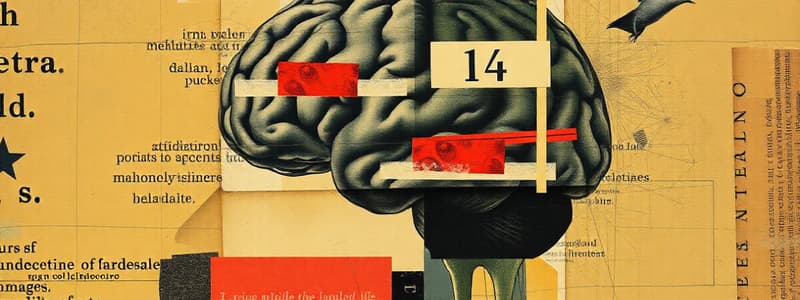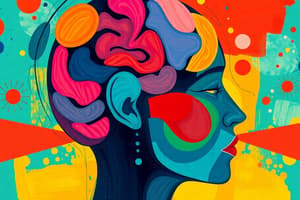Podcast
Questions and Answers
Which of the following areas is specifically associated with language production?
Which of the following areas is specifically associated with language production?
- Arcuate fasciculus
- Broca’s area (correct)
- Primary motor cortex
- Wernicke’s area
Aphasia can result from conditions other than a stroke.
Aphasia can result from conditions other than a stroke.
True (A)
What are the three types of cortical areas mentioned in relation to higher-order functions?
What are the three types of cortical areas mentioned in relation to higher-order functions?
Primary, Secondary, Tertiary
The area of the brain responsible for language comprehension is called __________.
The area of the brain responsible for language comprehension is called __________.
Match the following brain areas with their associated functions:
Match the following brain areas with their associated functions:
Which type of function is NOT typically classified under higher-order functions?
Which type of function is NOT typically classified under higher-order functions?
The Wernicke-Geschwind model suggests that language functions are represented linearly in the brain.
The Wernicke-Geschwind model suggests that language functions are represented linearly in the brain.
What is the primary role of the arcuate fasciculus in language processing?
What is the primary role of the arcuate fasciculus in language processing?
What condition is characterized by generalized difficulty in understanding, producing, or repeating speech?
What condition is characterized by generalized difficulty in understanding, producing, or repeating speech?
Dysarthria is classified as a language disorder.
Dysarthria is classified as a language disorder.
What type of amnesia involves the inability to form new explicit memories?
What type of amnesia involves the inability to form new explicit memories?
The part of the brain primarily associated with explicit long-term memory is the ______.
The part of the brain primarily associated with explicit long-term memory is the ______.
Match the following types of amnesia with their descriptions:
Match the following types of amnesia with their descriptions:
What type of material can lesions in the right hemisphere impair memory for?
What type of material can lesions in the right hemisphere impair memory for?
Frontal lobe damage is always guaranteed to impair all executive functions equally.
Frontal lobe damage is always guaranteed to impair all executive functions equally.
Who is the individual famously known for exhibiting changes in personality and social behavior due to frontal lobe damage?
Who is the individual famously known for exhibiting changes in personality and social behavior due to frontal lobe damage?
The term 'executive function' refers to control systems that implement different __________ strategies in response to both external and internal cues.
The term 'executive function' refers to control systems that implement different __________ strategies in response to both external and internal cues.
Match the following symptoms with their descriptions:
Match the following symptoms with their descriptions:
Which of the following types of aphasia involves fluent language production but includes jargon-like speech?
Which of the following types of aphasia involves fluent language production but includes jargon-like speech?
Anomic Aphasia is characterized by a complete inability to comprehend spoken language.
Anomic Aphasia is characterized by a complete inability to comprehend spoken language.
What is a common symptom of Broca's Aphasia?
What is a common symptom of Broca's Aphasia?
Patients with Wernicke's Aphasia often produce _______________ speech that includes over-used phrases.
Patients with Wernicke's Aphasia often produce _______________ speech that includes over-used phrases.
Match the type of aphasia with its characteristics:
Match the type of aphasia with its characteristics:
What kind of speech is typically produced in Broca's Aphasia?
What kind of speech is typically produced in Broca's Aphasia?
Circumlocutions are often a response to difficulty in naming objects, seen primarily in Anomic Aphasia.
Circumlocutions are often a response to difficulty in naming objects, seen primarily in Anomic Aphasia.
What type of aphasia is characterized as the mildest form and often occurs after recovery from a more severe type?
What type of aphasia is characterized as the mildest form and often occurs after recovery from a more severe type?
Flashcards
Broca's Area
Broca's Area
A brain region in the frontal operculum, crucial for language production. It's located in the frontal lobe.
Wernicke's Area
Wernicke's Area
A brain area in the superior temporal gyrus that plays a vital role in language comprehension.
Aphasia
Aphasia
An acquired language disorder that affects speech, reading, writing (can impact production, comprehension or both).
Arcuate Fasciculus
Arcuate Fasciculus
Signup and view all the flashcards
Primary Cortical Areas
Primary Cortical Areas
Signup and view all the flashcards
Secondary Cortical Areas
Secondary Cortical Areas
Signup and view all the flashcards
Tertiary Cortical Areas (Association Cortex)
Tertiary Cortical Areas (Association Cortex)
Signup and view all the flashcards
Wernicke-Geschwind model
Wernicke-Geschwind model
Signup and view all the flashcards
Global Aphasia
Global Aphasia
Signup and view all the flashcards
Dysarthria
Dysarthria
Signup and view all the flashcards
Explicit Memory
Explicit Memory
Signup and view all the flashcards
Anterograde Amnesia
Anterograde Amnesia
Signup and view all the flashcards
Material-Specific Amnesia
Material-Specific Amnesia
Signup and view all the flashcards
Wernicke's Aphasia
Wernicke's Aphasia
Signup and view all the flashcards
Broca's Aphasia
Broca's Aphasia
Signup and view all the flashcards
Anomic Aphasia
Anomic Aphasia
Signup and view all the flashcards
Fluent Aphasia
Fluent Aphasia
Signup and view all the flashcards
Non-Fluent Aphasia
Non-Fluent Aphasia
Signup and view all the flashcards
Comprehension Disorder
Comprehension Disorder
Signup and view all the flashcards
Production Disorder
Production Disorder
Signup and view all the flashcards
Right hemisphere lesions
Right hemisphere lesions
Signup and view all the flashcards
Executive functions
Executive functions
Signup and view all the flashcards
Frontal lobe damage symptoms
Frontal lobe damage symptoms
Signup and view all the flashcards
Wisconsin Card Sorting Task
Wisconsin Card Sorting Task
Signup and view all the flashcards
Causes of frontal lobe problems
Causes of frontal lobe problems
Signup and view all the flashcards
Study Notes
Higher Cortical Functions & Cognitive/Behavioral Manifestations of Brain Disorders
- Study resources for 7th edition include pages 10-12, 16-17, 366-370, 374, 382-384, 388-394, 421-422, 427, 440-446, 449-452, 575-580, 586, 607-609 in Chapter 18 and 19.
- Study resources for 8th edition include pages 9-11, 15, 337-341, 345, 352-354, 357, 363, 390-391, 395, 418, 528-530, 535, 538, 544, 554-556 in Chapter 18 and 19.
Brief Summary of Neocortical Function
- Primary areas project to spinal motor systems or receive sensory input (via thalamus).
- Secondary areas are adjacent to primary areas, interpret sensory and motor inputs, or organize movements.
- Tertiary (association) areas are located between secondary areas, not specific to sensory or motor, and modulate information between these areas.
Examples of "Higher-Order" Functions
- Language
- Memory
- Executive functions
- Perception
- Spatial behavior
- Attention
- Skilled movement
Main Anatomical Areas Associated with Language
- Left hemisphere Broca's area (in frontal operculum) and Wernicke's area (in superior temporal gyrus).
- "Perisylvian" areas are specialized for language.
- Additional areas include Brodmann areas 44 and 45 (Broca's area), and 22 (Wernicke's area).
Wernicke-Geschwind Model (1960s & 1970s)
- Arcuate fasciculus plays a role in language repetition involving production and comprehension.
- Wernicke's area processes spoken word input, Broca's area processes spoken word output, and the arcuate fasciculus connects the two.
- Other areas including area 41, the facial area of motor cortex, and cranial nerves are involved in language functions.
Revisions to Wernicke-Geschwind Model
- Original model is useful but detailed. Information has been revised due to improved lesion analysis and neuroimaging. Current models are network-based, not linear.
- Functions may be represented diffusely (e.g., semantics is not just in Wernicke's area). Broca's area contains mental representations of language, not just motor.
Disorders of Language
- Aphasia is an acquired language disorder affecting speech production and/or comprehension (and potentially reading or writing). Stroke is a common cause (>80% of cases).
- Aphasia can be broadly categorized into disorders of comprehension (e.g., fluent) and disorders of production (e.g., nonfluent).
Table 19.2 Summary of Symptoms of Language Disorders
- Specific symptoms of comprehension disorders include poor auditory comprehension and visual comprehension.
- Specific symptoms of production disorders include poor articulation, word-finding deficit (anomia), unintended word use (paraphasia), grammatical errors, repeating spoken material difficulties, low verbal fluency, writing difficulties (agraphia), and tone of voice difficulties (aprosidia).
Table 19.3 Definition of Aphasic Syndromes
- Provides definitions and symptoms for different aphasia types (fluent, Wernicke, conduction, anomic, nonfluent, Broca, expressive, mild, transcortical motor, global). Symptoms and causes of different aphasias are detailed.
Wernicke's Aphasia
- Difficulty comprehending and repeating speech produced by oneself or others.
- Language production is usually fluent but jargon-like and may include neologisms, paraphasias, and word relationships.
Anomic Aphasia
- Mildest form of aphasia, a residual deficit after recovery; difficulty finding specific words or objects. Language comprehension, production, and repetition are mostly intact.
Broca's Aphasia
- Most common clinically; difficulty with language production (slow, labored, and telegraphic speech). Comprehension is relatively good, but difficulty with syntactically complex sentences. Insight into linguistic abilities is generally preserved.
Global Aphasia
- Generalized difficulty with comprehending, producing, or repeating speech. Some automatic phrases may be spared. Caused by extensive left-hemisphere lesions
Dysarthria
- Distinctive from aphasia, not a language disorder. Speech disorders result from neuromuscular (motor) dysfunction. Motor-speech deficits depend on the affected system. Upper motor neurons, lower motor neurons (cranial nerves), and basal ganglia are specific examples.
Classification of Memory Systems
- Explicit (conscious) memory vs. Implicit (unconscious) memory.
- Explicit memory includes episodic (personal experiences), semantic (facts), and autobiographical (knowledge) memory. Implicit memory includes skills, habits, priming, and conditioning.
- Different memory systems have different neural substrates.
Main Anatomical Areas Associated with LT Explicit Memory
- Temporal lobe and proximal areas
- Prefrontal cortex (helps piece events together)
- Medial thalamus
Disorders of Memory
- Different memory systems impaired by varied damage.
- Amnesia is loss of memory.
- Anterograde amnesia is the inability to form new memories.
- Retrograde amnesia is the inability to access old memories.
Case HM (1926-2008)
- Severe anterograde amnesia for explicit memories following bilateral medial temporal lobe resection.
Material-Specific Amnesias
- Left and right hemispheres involved in encoding and retrieving different material types.
- Left-hemisphere lesions may impair verbal memory.
- Right-hemisphere lesions may impair visual/spatial memory.
Frontal-Lobe Function
- Primary motor, premotor, and prefrontal areas
- Prefrontal areas (e.g., dorsolateral, orbitofrontal) involved in executive functions.
Executive Function(s)
- Control systems implementing behavioral strategies in response to both external and internal cues.
- Extensive array of functions. Frontal damage does not necessarily impair all functions.
- Variability among patients.
FL Symptom Examples
- Impaired social behavior & personality changes (example: Phineas Gage).
- Loss of behavioral spontaneity (loss of initiative, motivation, apathy, decreased verbal fluency).
- Poor strategy formation and perseveration (Wisconsin Card Sorting Task).
Etiologies Affecting Frontal Lobe Functions
- Direct frontal lobe lesions (e.g., TBI, strokes, AD).
- Lesions in subcortical areas projecting to the frontal lobe (e.g., strokes, Parkinson's Disease, Huntington's Disease).
Studying That Suits You
Use AI to generate personalized quizzes and flashcards to suit your learning preferences.




